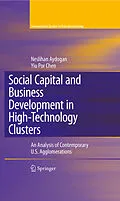The economics of regional clusters, where business formation, technological innovation, and the emergence of a highly-skilled labor force converge, has become a popular topic among academic researchers, entrepreneurs and investors, and policymakers alike. This book applies a variety of tools and models to analyze, in depth, the formation and growth of high-tech clusters, first by exploring the institutional forces that promote the failure or success of such agglomerations, and then by focusing on the dynamics of the labor force, including knowledge and skill transfer, job creation, and hiring practices. Considering the influence of such factors as geographical proximity, inter-firm networks, and ethnic and cultural features, the authors present a rigorous, empirical approach to the development of human and social capital in high-tech environments, with implications for business creation, organizational management, and institutional policymaking.
Zusammenfassung
Neslihan Aydogan It is now widely accepted that geographical proximity matters to economic and - cial life. Not only does it provide externalities that reduce transaction costs, but it also helps transacting parties form networks from which they can bene t greatly. More than ever, economists have been trying to bridge the development gap between poor and rich regions. Agglomerations are investigated toward that target because economists think that if certain regions can mix up that special formula to conti- ously innovate and produce, then understanding and forming such agglomerations could be one way to go about that growth path. We have designed the chapters of this book to work out the mechanics of geographical agglomerations in the United States with the focus of identifying the characteristics of such special formula Chapters 13 are designed to investigate the high-tech clusters that have sprung up in the United States due to their innovative capacity to engage in high-val- added activities. The rst question we ask is, What promotes the productivity of high-tech rms? We ask this question by taking into account the region in which a rm is located and the spillover effects of the region on the rm. In particular, we ask if the presence of a variety of industries or of similar industries promotes the productivity of high-tech rms. In this regard, we are interested in distingui- ing the high- and low-tech rms in terms of their driving factors.
Inhalt
How High-Tech Industries Benefit from the Economies of Agglomeration.- Tacit Knowledge Transfer, Geographical Proximity, and Inter-Firm Contracts: The Silicon Valley Case.- Reciprocity, Proximity and Performance of Research Consortia.- Citizenship, Social Capital, and Spatial Assimilation of Highly Skilled Labor and Location Choice.- Ethnic and Technical Clustering: Native-Born Americans Versus Foreign S&E Graduates.
